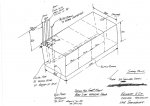G'day
I hope I'm not posting inappropriately, I did read on any topic but if this site is only for students just let me know and I'll ask elsewhere.
I've been trying to work out an accurate way to calibrate a dipstick for my boats fuel tanks. I would like to mark a dipstick in 10L increments so when the boat on trailer is all level I can calculate fuel usage fairly accurately.
If you can point me in the right direction that would be appreciated
Cheers
Rod
Adelaide

I hope I'm not posting inappropriately, I did read on any topic but if this site is only for students just let me know and I'll ask elsewhere.
I've been trying to work out an accurate way to calibrate a dipstick for my boats fuel tanks. I would like to mark a dipstick in 10L increments so when the boat on trailer is all level I can calculate fuel usage fairly accurately.
If you can point me in the right direction that would be appreciated
Cheers
Rod
Adelaide

